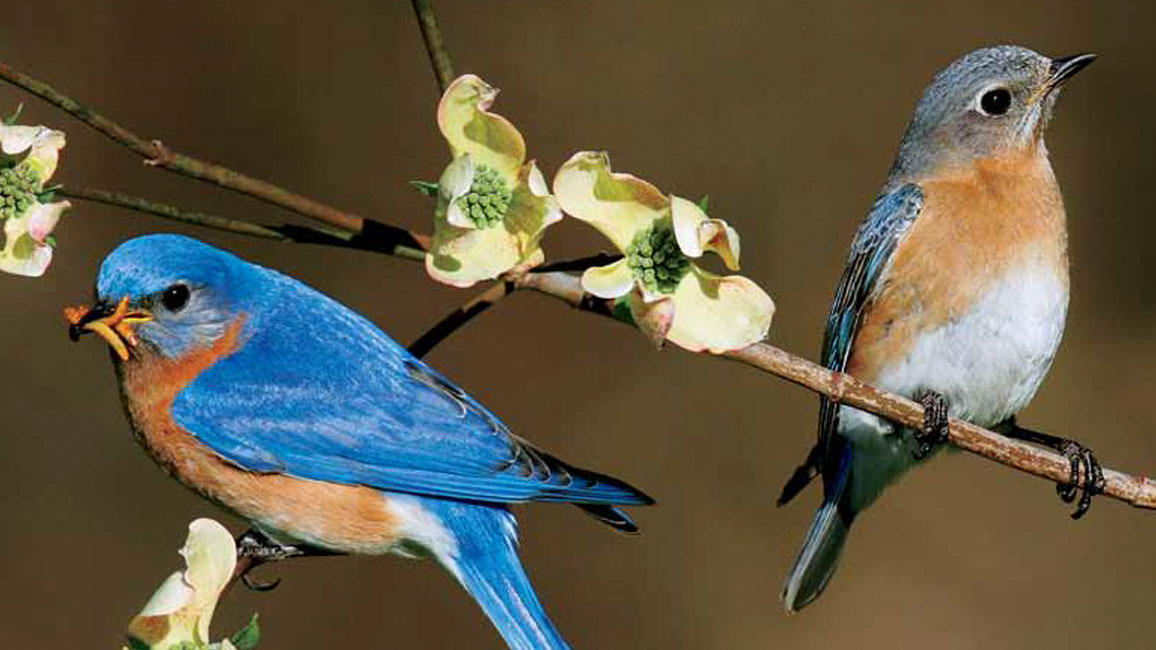
Bluebirds
By BluebirdsBluebird mates share the job of raising a family. Here’s the story of Happy and Joy, from meeting to courting to bringing up babies.
Bluebirds are a sunny sight. With their bright blue feathers and cheerful songs, they have long been a symbol of happiness.
Happy and Joy are male and female eastern bluebirds. This species lives throughout the eastern half of North America. Happy, the male, makes a pretty picture. He’s vivid blue across his back with a rusty red underside. Those bright colors helped him attract his mate.
Joy, the female, is more gray than blue. Her colors help her hide from predators, which will be especially important when she is taking care of chicks.
Showing Off
When nesting time comes around, Happy starts to show off. He finds a good place for a nest: maybe an old woodpecker hole or maybe a nest box that people have put up. Happy sits above the spot and waves his flashy blue wings to attract Joy’s attention. He carries bits of grass and other nest fixings in and out of the hole as if to say, “Look, wouldn’t this make a nice nest?” He may bring Joy a juicy caterpillar or some other bit of food. Finally, Joy follows him through the hole, agreeing to be his mate.
Laying Eggs
Now Joy gets down to the work of a mama bluebird. She builds the nest by herself, weaving together grasses and pine needles. Then she lays pale blue eggs—one per day—until she has five. For about two weeks, Joy sits on the eggs to keep them warm, while Happy brings her food to eat. Soon, the downy chicks hatch. Their eyes are closed, but their mouths are open wide to say, “Feed me!”
Tending House
Both parents share the job of getting food for the babies. Favorite bluebird meals include worms, insects, and fruits such as berries. Happy and Joy also clean up after the chicks. The babies’ droppings come out in little packages called fecal sacs. The sacs make it easier for the parents to “take out the trash,” which keeps the nest clean. Getting rid of the smelly sacs can also help keep predators from sniffing out the nest.

Taking Wing
When the baby bluebirds are two to three weeks old, they start to get restless in their tiny home. They’re now big enough to peek out of the nest hole at the wide world beyond. Happy and Joy lure the chicks out by bringing food close, but not all the way, to them. One by one, the young birds jump out of the nest hole and fly to nearby trees.
For the next few weeks, Joy and Happy keep bringing their babies things to eat. Soon the chicks begin following their parents and searching for food themselves. When the chicks are able to fly well and find plenty of food, they are ready to be on their own. But sometimes young bluebirds stay around longer. They help raise the next set of chicks—just as you might help take care of your younger brothers or sisters. Later, these busy bluebirds will get to work starting families of their own.
Family Ties
Eastern bluebirds (such as Happy and Joy) are one of three different bluebird species that live in the United States. The others are the western bluebird and the mountain bluebird. The male western bluebird looks a lot like the eastern one, except for his blue throat. But while the eastern bluebird prefers open fields with trees around the edges, the western bluebird lives in open forests. The mountain bluebird lives in ranchlands and other wide-open places, breeding in mountainous areas. And in this species, the male is sky blue all over, without reddish underparts.
“Bluebirds” originally appeared in the June/July 2010 issue of Ranger Rick magazine.
(Click on each image above for a closer view of the story.)

















